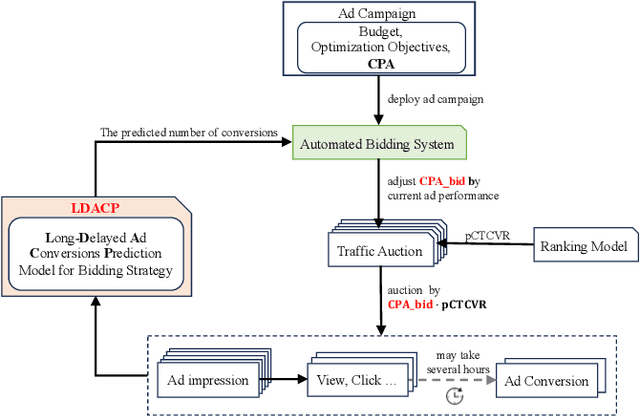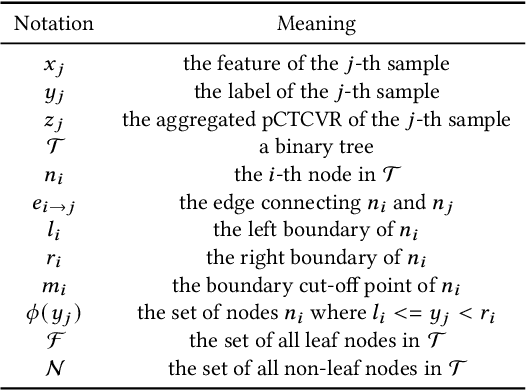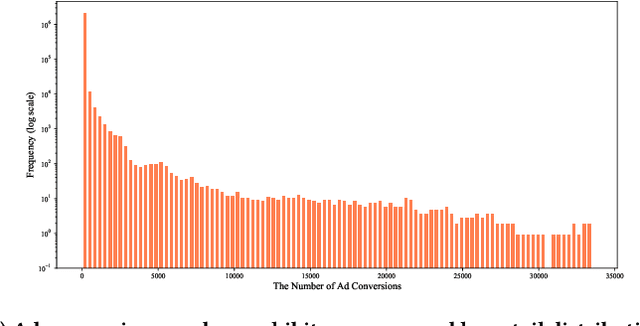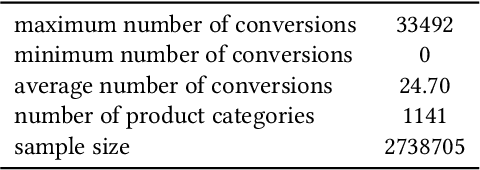Qingpeng Cai
Kuaishou Technology
Generative Auto-Bidding in Large-Scale Competitive Auctions via Diffusion Completer-Aligner
Sep 03, 2025Abstract:Auto-bidding is central to computational advertising, achieving notable commercial success by optimizing advertisers' bids within economic constraints. Recently, large generative models show potential to revolutionize auto-bidding by generating bids that could flexibly adapt to complex, competitive environments. Among them, diffusers stand out for their ability to address sparse-reward challenges by focusing on trajectory-level accumulated rewards, as well as their explainable capability, i.e., planning a future trajectory of states and executing bids accordingly. However, diffusers struggle with generation uncertainty, particularly regarding dynamic legitimacy between adjacent states, which can lead to poor bids and further cause significant loss of ad impression opportunities when competing with other advertisers in a highly competitive auction environment. To address it, we propose a Causal auto-Bidding method based on a Diffusion completer-aligner framework, termed CBD. Firstly, we augment the diffusion training process with an extra random variable t, where the model observes t-length historical sequences with the goal of completing the remaining sequence, thereby enhancing the generated sequences' dynamic legitimacy. Then, we employ a trajectory-level return model to refine the generated trajectories, aligning more closely with advertisers' objectives. Experimental results across diverse settings demonstrate that our approach not only achieves superior performance on large-scale auto-bidding benchmarks, such as a 29.9% improvement in conversion value in the challenging sparse-reward auction setting, but also delivers significant improvements on the Kuaishou online advertising platform, including a 2.0% increase in target cost.
Navigate the Unknown: Enhancing LLM Reasoning with Intrinsic Motivation Guided Exploration
May 23, 2025Abstract:Reinforcement learning (RL) has emerged as a pivotal method for improving the reasoning capabilities of Large Language Models (LLMs). However, prevalent RL approaches such as Proximal Policy Optimization (PPO) and Group-Regularized Policy Optimization (GRPO) face critical limitations due to their reliance on sparse outcome-based rewards and inadequate mechanisms for incentivizing exploration. These limitations result in inefficient guidance for multi-step reasoning processes. Specifically, sparse reward signals fail to deliver effective or sufficient feedback, particularly for challenging problems. Furthermore, such reward structures induce systematic biases that prioritize exploitation of familiar trajectories over novel solution discovery. These shortcomings critically hinder performance in complex reasoning tasks, which inherently demand iterative refinement across ipntermediate steps. To address these challenges, we propose an Intrinsic Motivation guidEd exploratioN meThOd foR LLM Reasoning (i-MENTOR), a novel method designed to both deliver dense rewards and amplify explorations in the RL-based training paradigm. i-MENTOR introduces three key innovations: trajectory-aware exploration rewards that mitigate bias in token-level strategies while maintaining computational efficiency; dynamic reward scaling to stabilize exploration and exploitation in large action spaces; and advantage-preserving reward implementation that maintains advantage distribution integrity while incorporating exploratory guidance. Experiments across three public datasets demonstrate i-MENTOR's effectiveness with a 22.39% improvement on the difficult dataset Countdown-4.
Generative Auto-Bidding with Value-Guided Explorations
Apr 20, 2025Abstract:Auto-bidding, with its strong capability to optimize bidding decisions within dynamic and competitive online environments, has become a pivotal strategy for advertising platforms. Existing approaches typically employ rule-based strategies or Reinforcement Learning (RL) techniques. However, rule-based strategies lack the flexibility to adapt to time-varying market conditions, and RL-based methods struggle to capture essential historical dependencies and observations within Markov Decision Process (MDP) frameworks. Furthermore, these approaches often face challenges in ensuring strategy adaptability across diverse advertising objectives. Additionally, as offline training methods are increasingly adopted to facilitate the deployment and maintenance of stable online strategies, the issues of documented behavioral patterns and behavioral collapse resulting from training on fixed offline datasets become increasingly significant. To address these limitations, this paper introduces a novel offline Generative Auto-bidding framework with Value-Guided Explorations (GAVE). GAVE accommodates various advertising objectives through a score-based Return-To-Go (RTG) module. Moreover, GAVE integrates an action exploration mechanism with an RTG-based evaluation method to explore novel actions while ensuring stability-preserving updates. A learnable value function is also designed to guide the direction of action exploration and mitigate Out-of-Distribution (OOD) problems. Experimental results on two offline datasets and real-world deployments demonstrate that GAVE outperforms state-of-the-art baselines in both offline evaluations and online A/B tests. The implementation code is publicly available to facilitate reproducibility and further research.
From Principles to Applications: A Comprehensive Survey of Discrete Tokenizers in Generation, Comprehension, Recommendation, and Information Retrieval
Feb 18, 2025Abstract:Discrete tokenizers have emerged as indispensable components in modern machine learning systems, particularly within the context of autoregressive modeling and large language models (LLMs). These tokenizers serve as the critical interface that transforms raw, unstructured data from diverse modalities into discrete tokens, enabling LLMs to operate effectively across a wide range of tasks. Despite their central role in generation, comprehension, and recommendation systems, a comprehensive survey dedicated to discrete tokenizers remains conspicuously absent in the literature. This paper addresses this gap by providing a systematic review of the design principles, applications, and challenges of discrete tokenizers. We begin by dissecting the sub-modules of tokenizers and systematically demonstrate their internal mechanisms to provide a comprehensive understanding of their functionality and design. Building on this foundation, we synthesize state-of-the-art methods, categorizing them into multimodal generation and comprehension tasks, and semantic tokens for personalized recommendations. Furthermore, we critically analyze the limitations of existing tokenizers and outline promising directions for future research. By presenting a unified framework for understanding discrete tokenizers, this survey aims to guide researchers and practitioners in addressing open challenges and advancing the field, ultimately contributing to the development of more robust and versatile AI systems.
Value Function Decomposition in Markov Recommendation Process
Jan 29, 2025



Abstract:Recent advances in recommender systems have shown that user-system interaction essentially formulates long-term optimization problems, and online reinforcement learning can be adopted to improve recommendation performance. The general solution framework incorporates a value function that estimates the user's expected cumulative rewards in the future and guides the training of the recommendation policy. To avoid local maxima, the policy may explore potential high-quality actions during inference to increase the chance of finding better future rewards. To accommodate the stepwise recommendation process, one widely adopted approach to learning the value function is learning from the difference between the values of two consecutive states of a user. However, we argue that this paradigm involves an incorrect approximation in the stochastic process. Specifically, between the current state and the next state in each training sample, there exist two separate random factors from the stochastic policy and the uncertain user environment. Original temporal difference (TD) learning under these mixed random factors may result in a suboptimal estimation of the long-term rewards. As a solution, we show that these two factors can be separately approximated by decomposing the original temporal difference loss. The disentangled learning framework can achieve a more accurate estimation with faster learning and improved robustness against action exploration. As empirical verification of our proposed method, we conduct offline experiments with online simulated environments built based on public datasets.
Future-Conditioned Recommendations with Multi-Objective Controllable Decision Transformer
Jan 13, 2025Abstract:Securing long-term success is the ultimate aim of recommender systems, demanding strategies capable of foreseeing and shaping the impact of decisions on future user satisfaction. Current recommendation strategies grapple with two significant hurdles. Firstly, the future impacts of recommendation decisions remain obscured, rendering it impractical to evaluate them through direct optimization of immediate metrics. Secondly, conflicts often emerge between multiple objectives, like enhancing accuracy versus exploring diverse recommendations. Existing strategies, trapped in a "training, evaluation, and retraining" loop, grow more labor-intensive as objectives evolve. To address these challenges, we introduce a future-conditioned strategy for multi-objective controllable recommendations, allowing for the direct specification of future objectives and empowering the model to generate item sequences that align with these goals autoregressively. We present the Multi-Objective Controllable Decision Transformer (MocDT), an offline Reinforcement Learning (RL) model capable of autonomously learning the mapping from multiple objectives to item sequences, leveraging extensive offline data. Consequently, it can produce recommendations tailored to any specified objectives during the inference stage. Our empirical findings emphasize the controllable recommendation strategy's ability to produce item sequences according to different objectives while maintaining performance that is competitive with current recommendation strategies across various objectives.
LLM-Powered User Simulator for Recommender System
Dec 22, 2024



Abstract:User simulators can rapidly generate a large volume of timely user behavior data, providing a testing platform for reinforcement learning-based recommender systems, thus accelerating their iteration and optimization. However, prevalent user simulators generally suffer from significant limitations, including the opacity of user preference modeling and the incapability of evaluating simulation accuracy. In this paper, we introduce an LLM-powered user simulator to simulate user engagement with items in an explicit manner, thereby enhancing the efficiency and effectiveness of reinforcement learning-based recommender systems training. Specifically, we identify the explicit logic of user preferences, leverage LLMs to analyze item characteristics and distill user sentiments, and design a logical model to imitate real human engagement. By integrating a statistical model, we further enhance the reliability of the simulation, proposing an ensemble model that synergizes logical and statistical insights for user interaction simulations. Capitalizing on the extensive knowledge and semantic generation capabilities of LLMs, our user simulator faithfully emulates user behaviors and preferences, yielding high-fidelity training data that enrich the training of recommendation algorithms. We establish quantifying and qualifying experiments on five datasets to validate the simulator's effectiveness and stability across various recommendation scenarios.
GAS: Generative Auto-bidding with Post-training Search
Dec 22, 2024



Abstract:Auto-bidding is essential in facilitating online advertising by automatically placing bids on behalf of advertisers. Generative auto-bidding, which generates bids based on an adjustable condition using models like transformers and diffusers, has recently emerged as a new trend due to its potential to learn optimal strategies directly from data and adjust flexibly to preferences. However, generative models suffer from low-quality data leading to a mismatch between condition, return to go, and true action value, especially in long sequential decision-making. Besides, the majority preference in the dataset may hinder models' generalization ability on minority advertisers' preferences. While it is possible to collect high-quality data and retrain multiple models for different preferences, the high cost makes it unaffordable, hindering the advancement of auto-bidding into the era of large foundation models. To address this, we propose a flexible and practical Generative Auto-bidding scheme using post-training Search, termed GAS, to refine a base policy model's output and adapt to various preferences. We use weak-to-strong search alignment by training small critics for different preferences and an MCTS-inspired search to refine the model's output. Specifically, a novel voting mechanism with transformer-based critics trained with policy indications could enhance search alignment performance. Additionally, utilizing the search, we provide a fine-tuning method for high-frequency preference scenarios considering computational efficiency. Extensive experiments conducted on the real-world dataset and online A/B test on the Kuaishou advertising platform demonstrate the effectiveness of GAS, achieving significant improvements, e.g., 1.554% increment of target cost.
ACQ: A Unified Framework for Automated Programmatic Creativity in Online Advertising
Dec 09, 2024Abstract:In online advertising, the demand-side platform (a.k.a. DSP) enables advertisers to create different ad creatives for real-time bidding. Intuitively, advertisers tend to create more ad creatives for a single photo to increase the probability of participating in bidding, further enhancing their ad cost. From the perspective of DSP, the following are two overlooked issues. On the one hand, the number of ad creatives cannot grow indefinitely. On the other hand, the marginal effects of ad cost diminish as the number of ad creatives increases. To this end, this paper proposes a two-stage framework named Automated Creatives Quota (ACQ) to achieve the automatic creation and deactivation of ad creatives. ACQ dynamically allocates the creative quota across multiple advertisers to maximize the revenue of the ad platform. ACQ comprises two components: a prediction module to estimate the cost of a photo under different numbers of ad creatives, and an allocation module to decide the quota for photos considering their estimated costs in the prediction module. Specifically, in the prediction module, we develop a multi-task learning model based on an unbalanced binary tree to effectively mitigate the target variable imbalance problem. In the allocation module, we formulate the quota allocation problem as a multiple-choice knapsack problem (MCKP) and develop an efficient solver to solve such large-scale problems involving tens of millions of ads. We performed extensive offline and online experiments to validate the superiority of our proposed framework, which increased cost by 9.34%.
LDACP: Long-Delayed Ad Conversions Prediction Model for Bidding Strategy
Nov 25, 2024



Abstract:In online advertising, once an ad campaign is deployed, the automated bidding system dynamically adjusts the bidding strategy to optimize Cost Per Action (CPA) based on the number of ad conversions. For ads with a long conversion delay, relying solely on the real-time tracked conversion number as a signal for bidding strategy can significantly overestimate the current CPA, leading to conservative bidding strategies. Therefore, it is crucial to predict the number of long-delayed conversions. Nonetheless, it is challenging to predict ad conversion numbers through traditional regression methods due to the wide range of ad conversion numbers. Previous regression works have addressed this challenge by transforming regression problems into bucket classification problems, achieving success in various scenarios. However, specific challenges arise when predicting the number of ad conversions: 1) The integer nature of ad conversion numbers exacerbates the discontinuity issue in one-hot hard labels; 2) The long-tail distribution of ad conversion numbers complicates tail data prediction. In this paper, we propose the Long-Delayed Ad Conversions Prediction model for bidding strategy (LDACP), which consists of two sub-modules. To alleviate the issue of discontinuity in one-hot hard labels, the Bucket Classification Module with label Smoothing method (BCMS) converts one-hot hard labels into non-normalized soft labels, then fits these soft labels by minimizing classification loss and regression loss. To address the challenge of predicting tail data, the Value Regression Module with Proxy labels (VRMP) uses the prediction bias of aggregated pCTCVR as proxy labels. Finally, a Mixture of Experts (MoE) structure integrates the predictions from BCMS and VRMP to obtain the final predicted ad conversion number.
 Add to Chrome
Add to Chrome Add to Firefox
Add to Firefox Add to Edge
Add to Edge